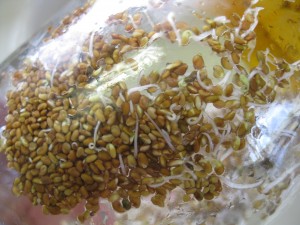





Summertime provides an abundance of fresh vegetables. Farmers markets flourish and grocery stores are brimming with robust seasonal produce. Those of us with gardens get spoiled with an endless supply. With winter upon us, the variety of available fresh vegetables is more limited. I freeze a lot from the garden for winter use but I miss the fresh garden greens the most. One of the best, and least expensive, ways to add fresh greens to our diets in the winter is by making sprouts.
Sprout seeds are inexpensive. Especially because a small amount of seed becomes a much larger amount of sprouts. There are many different types of seeds that you can turn into sprouts. Probably the most common is alfalfa seed. I also like many of the seed mixes that combine radish seed, broccoli seed, alfalfa seed, and a variety of others. These mixes produce spicier tasting sprouts than straight alfalfa. Some of the larger beans like mung beans and lentils, are good for eating raw as well as adding to stir-fries.
Making sprouts is easy. It takes a few days from start to finish but involves almost no effort at all. Here is a tutorial to show you how it’s done to get you started. Once you see how easy it is, you will want to experiment with lots of different kinds to see which ones you like best.

I start with a wide mouth canning jar and a sprouting lid. Before I got these lids I just placed a piece of screen on the top of the jar. I held it on by screwing the ring part of the canning jar lid over the net to hold it in place. These lids are nice because there are smaller and bigger holes for different sized seeds or beans. You want to use the right size so the seeds don’t fall out but also drain easily. We’ll get to the draining part shortly.

I just used a household Tablespoon this time. You can use up to 3 Tablespoons to one quart size jar.

Place them in the bottom of the jar.

Add enough water to very well cover the seeds. Let them soak overnight.

The next day, drain off the soaking water.

Add fresh water and rinse the seeds well by swishing the new water around a few times.

Drain off the fresh rinse water.

Prop the jar up at an angle where it can drain onto a saucer or small bowl. It is important for the seeds to stay moist but not wet. So, you want to rinse them twice each day to stay moist but you want the excess water to drain off.

Drain and rinse night and morning.

By the second day you’ll begin to see a little sprouting starting to happen.


By the third day you’ll see more sprouting action.

At this point you want to wrap the jar in a towel. You want to create a dark environment so they don’t leaf out too soon. When sprouts fully leaf out, the protein in the seeds and sprouts convert to carbohydrate in the leaves. We want to preserve the protein content. Place the jar on a dish towel like this.

Roll it up.

Cover the jar leaving the drain end open.

Fold the towel over the bottom end of the jar so no light gets to the seeds.

Prop the jar up like before.

The next day they should look like this. Continue rinsing 2x per day.

When they begin forming leaves, they are ready to eat.

These are perfectly sprouted seeds. They are much fresher and less expensive than the sprouts you buy at the store.

Place them on your salad and enjoy the crunchy goodness! Oh, and when you’ve finished, be sure to start another batch of sprouts! You can make a much bigger batch and store the sprouts in the fridge for several days. This will keep you in sprouts while the new batch is sprouting. These micro-greens are nutritious and the perfect way to add more greens to your winter fare.
It’s going to be ending of mine day, however before ending
I am reading this great article to improve my experience.
I do not even understand how I finished up here, however I thought
this submit was great. I do not recognize who you’re however certainly you are going to a famous blogger in case you
are not already. Cheers!